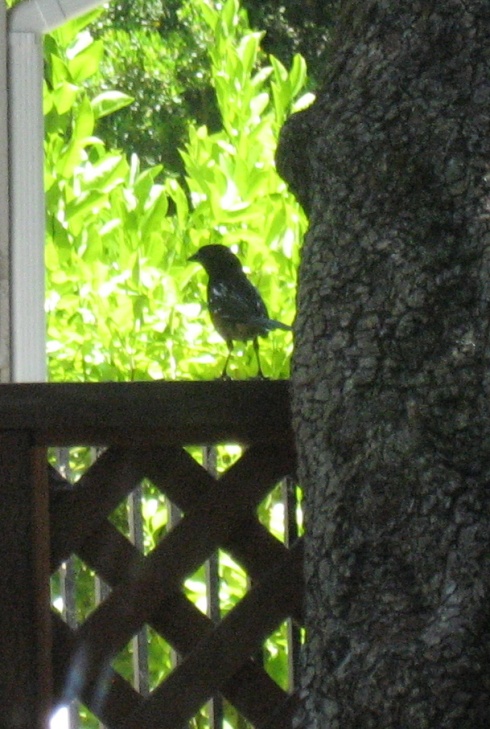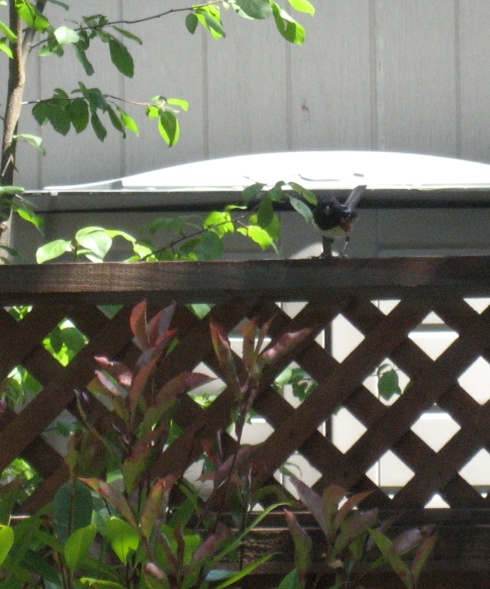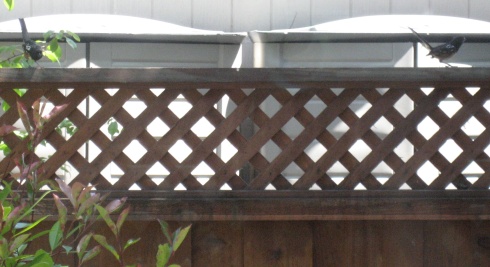
The Rufous-Sided Towhee has a scientific name that is nearly impossible to pronounce (Pipilo erythrophthalmus). Translated it means “red-eyed chirper” refering to the red eye and its most common call, “chewink”. In fact, this bird is sometimes called Chewink. The Eastern and Spotted Towhee were once considered a single species (Rufous-sided Towhee) but not any longer.
 This information covers the general habits and identifications of Towhee’s. The appearance of this bird varies in different parts of the country. Male Towhees are 7 to 9 inches in length, the eastern birds have dark heads and backs, rufous sides, a white belly, and a red eye. In the West they have a similar appearance except that they also have white spots on their dark wings and back. And in the South they may have a white eye instead of red. Females are smiliar to the males in appearance, but the black areas are more of a brown or brownish gray. Mating Habits You’ll most likely hear these birds than see them since they are a secretive bird.
This information covers the general habits and identifications of Towhee’s. The appearance of this bird varies in different parts of the country. Male Towhees are 7 to 9 inches in length, the eastern birds have dark heads and backs, rufous sides, a white belly, and a red eye. In the West they have a similar appearance except that they also have white spots on their dark wings and back. And in the South they may have a white eye instead of red. Females are smiliar to the males in appearance, but the black areas are more of a brown or brownish gray. Mating Habits You’ll most likely hear these birds than see them since they are a secretive bird.  Males usually arrive first and begin singing to announce and defend their territory of about 1 1/2 to 2 acres. When the female arrives and the two pair, the male will discontinue his singing and the pair will begin using the “chewink” call to keep in contact with one another. Nesting Habits The female does all building of the nest. A cup of grass, twigs and rootlets hidden on the ground, usually under the bough of a tree or shrub. These nests can be difficult to find since the female does not fly directly to the nest. Instead,
Males usually arrive first and begin singing to announce and defend their territory of about 1 1/2 to 2 acres. When the female arrives and the two pair, the male will discontinue his singing and the pair will begin using the “chewink” call to keep in contact with one another. Nesting Habits The female does all building of the nest. A cup of grass, twigs and rootlets hidden on the ground, usually under the bough of a tree or shrub. These nests can be difficult to find since the female does not fly directly to the nest. Instead, she lands a few feet away and using the cover of brush, walks to the nest. The female lays 2 to 6 cream-colored or greenish eggs that are spotted with brown which she incubates for 12 – 13 days. The young will leave the nest in 10 – 12 days after hatching. During nest building and incubation, the male towhee will rarely come near the nest. After the young hatch, the male helps feed the nestlings. Feeding Habits The feeding habits of the Towhee are a bit unusual. A ground feeding bird, their behavior is similar to that of the white-throated sparrow.
she lands a few feet away and using the cover of brush, walks to the nest. The female lays 2 to 6 cream-colored or greenish eggs that are spotted with brown which she incubates for 12 – 13 days. The young will leave the nest in 10 – 12 days after hatching. During nest building and incubation, the male towhee will rarely come near the nest. After the young hatch, the male helps feed the nestlings. Feeding Habits The feeding habits of the Towhee are a bit unusual. A ground feeding bird, their behavior is similar to that of the white-throated sparrow. They hop forward and then jump backward, dragging their feet to pull leaves and debris to reveal insects and seeds. These birds are primarily seed and berry eaters, they will eat insects during spring and summer when found on the ground. A ground platform feeder placed near underbrush may attract the Towhee to feed in your yard. Keeping in mind the slightest disturbance will have them diving for cover.
They hop forward and then jump backward, dragging their feet to pull leaves and debris to reveal insects and seeds. These birds are primarily seed and berry eaters, they will eat insects during spring and summer when found on the ground. A ground platform feeder placed near underbrush may attract the Towhee to feed in your yard. Keeping in mind the slightest disturbance will have them diving for cover.Category ›
 Unknown
Unknown
 Friday, November 9, 2012
Friday, November 9, 2012









No comments:
Post a Comment